Coca Cola Amatil: Marketing Management, Strategies and Analysis
VerifiedAdded on 2023/05/31
|14
|3591
|91
Report
AI Summary
This report provides a detailed analysis of Coca Cola Amatil's (CCA) marketing management strategies, focusing on segmentation, targeting, and positioning within the beverage industry. It begins with an overview of the industry market, including growth and profitability, followed by a PESTLE analysis to assess the macro-environmental factors affecting CCA. The report examines the nature of competition, comparing CCA's market position against major competitors like Nestle, highlighting strengths and weaknesses. It identifies primary (kids and youngsters) and secondary (women, households, and adults) market segments, evaluating the level of involvement of the primary segment in purchasing decisions. A positioning map is included to visually represent CCA's market positioning. The report concludes by summarizing the key findings and emphasizing the importance of market segmentation, targeting, and positioning for CCA's success in the global market. Desklib offers similar solved assignments for students.

Marketing management
Paraphrase This Document
Need a fresh take? Get an instant paraphrase of this document with our AI Paraphraser
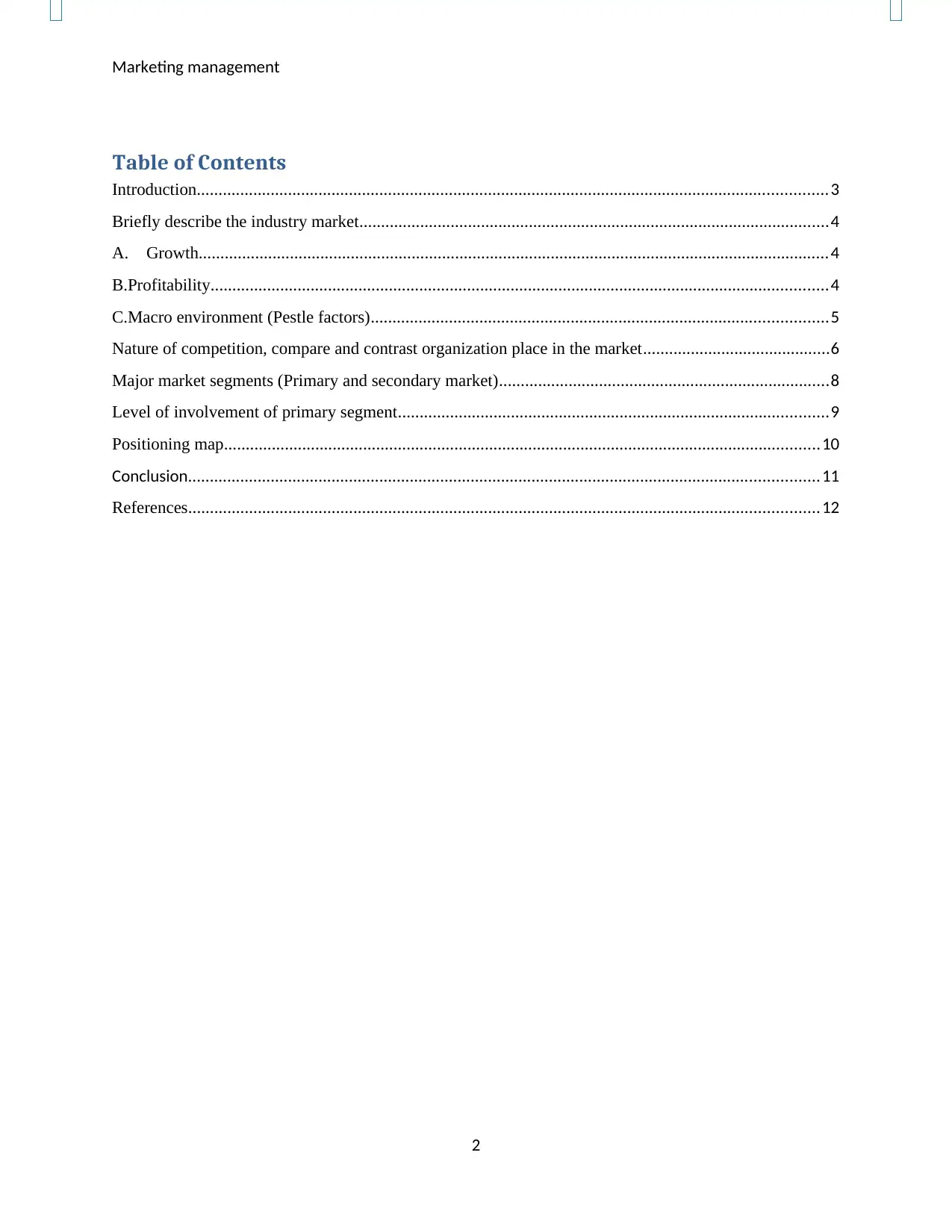
Marketing management
Table of Contents
Introduction.................................................................................................................................................3
Briefly describe the industry market............................................................................................................4
A. Growth.................................................................................................................................................4
B.Profitability..............................................................................................................................................4
C.Macro environment (Pestle factors).........................................................................................................5
Nature of competition, compare and contrast organization place in the market...........................................6
Major market segments (Primary and secondary market)............................................................................8
Level of involvement of primary segment...................................................................................................9
Positioning map.........................................................................................................................................10
Conclusion.................................................................................................................................................11
References.................................................................................................................................................12
2
Table of Contents
Introduction.................................................................................................................................................3
Briefly describe the industry market............................................................................................................4
A. Growth.................................................................................................................................................4
B.Profitability..............................................................................................................................................4
C.Macro environment (Pestle factors).........................................................................................................5
Nature of competition, compare and contrast organization place in the market...........................................6
Major market segments (Primary and secondary market)............................................................................8
Level of involvement of primary segment...................................................................................................9
Positioning map.........................................................................................................................................10
Conclusion.................................................................................................................................................11
References.................................................................................................................................................12
2
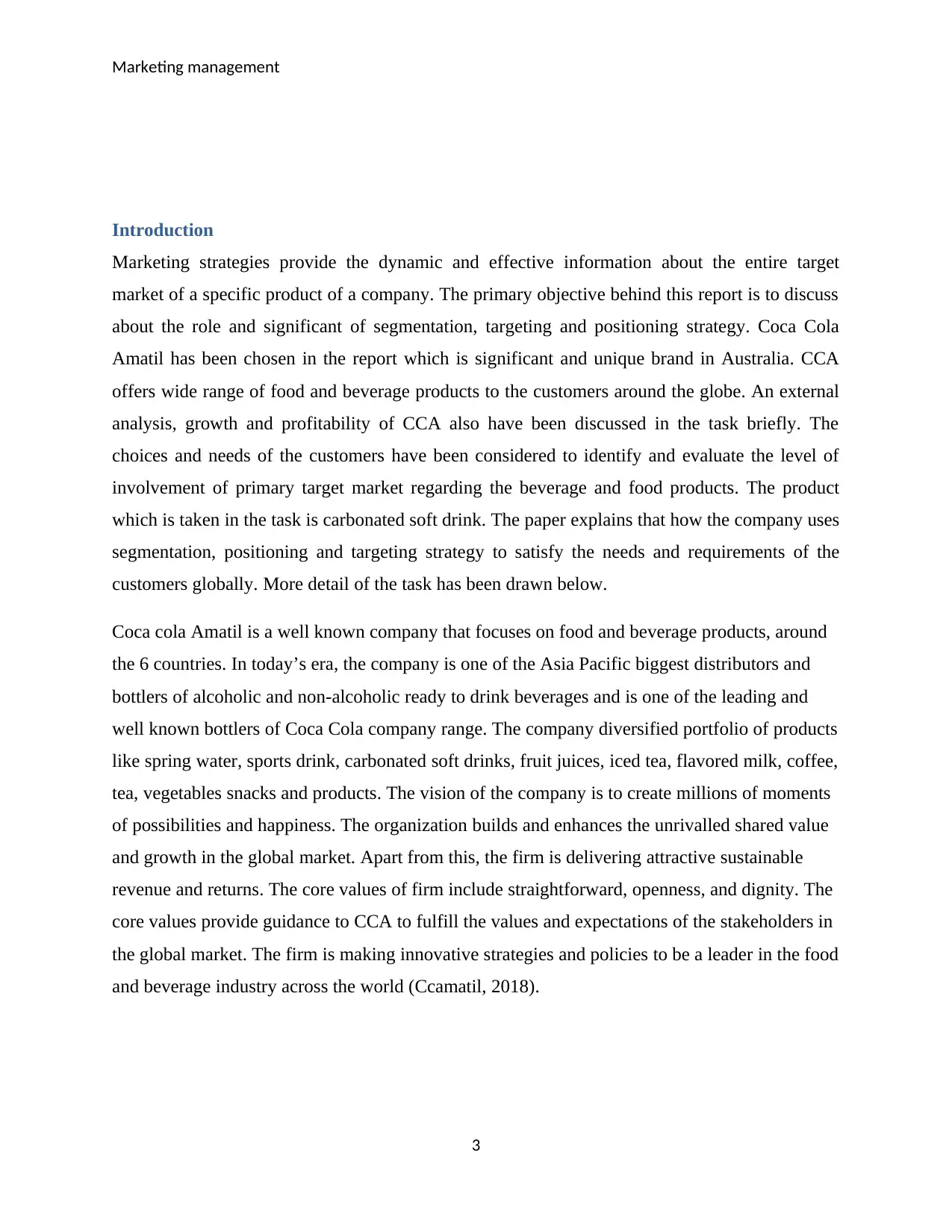
Marketing management
Introduction
Marketing strategies provide the dynamic and effective information about the entire target
market of a specific product of a company. The primary objective behind this report is to discuss
about the role and significant of segmentation, targeting and positioning strategy. Coca Cola
Amatil has been chosen in the report which is significant and unique brand in Australia. CCA
offers wide range of food and beverage products to the customers around the globe. An external
analysis, growth and profitability of CCA also have been discussed in the task briefly. The
choices and needs of the customers have been considered to identify and evaluate the level of
involvement of primary target market regarding the beverage and food products. The product
which is taken in the task is carbonated soft drink. The paper explains that how the company uses
segmentation, positioning and targeting strategy to satisfy the needs and requirements of the
customers globally. More detail of the task has been drawn below.
Coca cola Amatil is a well known company that focuses on food and beverage products, around
the 6 countries. In today’s era, the company is one of the Asia Pacific biggest distributors and
bottlers of alcoholic and non-alcoholic ready to drink beverages and is one of the leading and
well known bottlers of Coca Cola company range. The company diversified portfolio of products
like spring water, sports drink, carbonated soft drinks, fruit juices, iced tea, flavored milk, coffee,
tea, vegetables snacks and products. The vision of the company is to create millions of moments
of possibilities and happiness. The organization builds and enhances the unrivalled shared value
and growth in the global market. Apart from this, the firm is delivering attractive sustainable
revenue and returns. The core values of firm include straightforward, openness, and dignity. The
core values provide guidance to CCA to fulfill the values and expectations of the stakeholders in
the global market. The firm is making innovative strategies and policies to be a leader in the food
and beverage industry across the world (Ccamatil, 2018).
3
Introduction
Marketing strategies provide the dynamic and effective information about the entire target
market of a specific product of a company. The primary objective behind this report is to discuss
about the role and significant of segmentation, targeting and positioning strategy. Coca Cola
Amatil has been chosen in the report which is significant and unique brand in Australia. CCA
offers wide range of food and beverage products to the customers around the globe. An external
analysis, growth and profitability of CCA also have been discussed in the task briefly. The
choices and needs of the customers have been considered to identify and evaluate the level of
involvement of primary target market regarding the beverage and food products. The product
which is taken in the task is carbonated soft drink. The paper explains that how the company uses
segmentation, positioning and targeting strategy to satisfy the needs and requirements of the
customers globally. More detail of the task has been drawn below.
Coca cola Amatil is a well known company that focuses on food and beverage products, around
the 6 countries. In today’s era, the company is one of the Asia Pacific biggest distributors and
bottlers of alcoholic and non-alcoholic ready to drink beverages and is one of the leading and
well known bottlers of Coca Cola company range. The company diversified portfolio of products
like spring water, sports drink, carbonated soft drinks, fruit juices, iced tea, flavored milk, coffee,
tea, vegetables snacks and products. The vision of the company is to create millions of moments
of possibilities and happiness. The organization builds and enhances the unrivalled shared value
and growth in the global market. Apart from this, the firm is delivering attractive sustainable
revenue and returns. The core values of firm include straightforward, openness, and dignity. The
core values provide guidance to CCA to fulfill the values and expectations of the stakeholders in
the global market. The firm is making innovative strategies and policies to be a leader in the food
and beverage industry across the world (Ccamatil, 2018).
3
⊘ This is a preview!⊘
Do you want full access?
Subscribe today to unlock all pages.

Trusted by 1+ million students worldwide

Marketing management
Briefly describe the industry market
A. Growth
It has been studied that the company is increasing and enhancing the growth and success in the
global market by rendering excellent food and beverage products to the customers. There are
approx 14,000 employees working in the New Zealand, Fiji, Australia, Indonesia, Samoa, and
Papua New Guinea. The company works as one team to render best everyday for the consumers,
partners, communities, customers and shareholders who all benefits from CCA success and
growth. The firm has approx 115,000 customers in all over the world. The revenue of CCA was
USD 4.11 million and net earnings of USD 0.38 million (Capitalcube, 2018).
(Source: Capitalcube, 2018).
B.Profitability
CCA has offered an increase of 80.9% rise in annual net profit to $445.2million with the big
increase aspects to one off writedown from the last year. CCA share performance is increasing
day by day with increasing the selling of the food and beverage products in the competitive
market. The trading revenue of CCA was $4.933b in 2017 and underlying NPAT was $416.2m.
The company has access to more than 270 million potential and dynamic consumers through
more than 950,000 active and effective customers (Ccamatil, 2017).
4
Briefly describe the industry market
A. Growth
It has been studied that the company is increasing and enhancing the growth and success in the
global market by rendering excellent food and beverage products to the customers. There are
approx 14,000 employees working in the New Zealand, Fiji, Australia, Indonesia, Samoa, and
Papua New Guinea. The company works as one team to render best everyday for the consumers,
partners, communities, customers and shareholders who all benefits from CCA success and
growth. The firm has approx 115,000 customers in all over the world. The revenue of CCA was
USD 4.11 million and net earnings of USD 0.38 million (Capitalcube, 2018).
(Source: Capitalcube, 2018).
B.Profitability
CCA has offered an increase of 80.9% rise in annual net profit to $445.2million with the big
increase aspects to one off writedown from the last year. CCA share performance is increasing
day by day with increasing the selling of the food and beverage products in the competitive
market. The trading revenue of CCA was $4.933b in 2017 and underlying NPAT was $416.2m.
The company has access to more than 270 million potential and dynamic consumers through
more than 950,000 active and effective customers (Ccamatil, 2017).
4
Paraphrase This Document
Need a fresh take? Get an instant paraphrase of this document with our AI Paraphraser
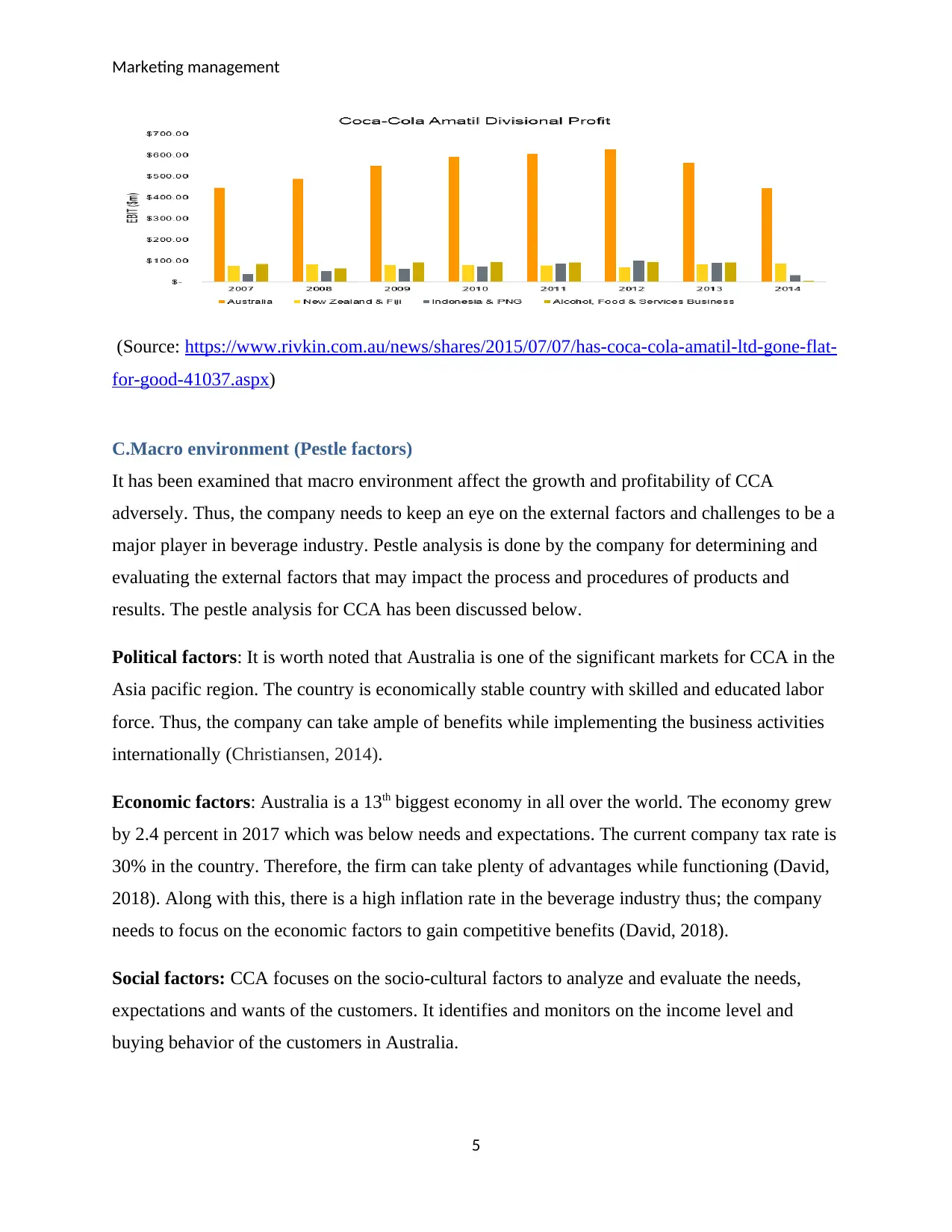
Marketing management
(Source: https://www.rivkin.com.au/news/shares/2015/07/07/has-coca-cola-amatil-ltd-gone-flat-
for-good-41037.aspx)
C.Macro environment (Pestle factors)
It has been examined that macro environment affect the growth and profitability of CCA
adversely. Thus, the company needs to keep an eye on the external factors and challenges to be a
major player in beverage industry. Pestle analysis is done by the company for determining and
evaluating the external factors that may impact the process and procedures of products and
results. The pestle analysis for CCA has been discussed below.
Political factors: It is worth noted that Australia is one of the significant markets for CCA in the
Asia pacific region. The country is economically stable country with skilled and educated labor
force. Thus, the company can take ample of benefits while implementing the business activities
internationally (Christiansen, 2014).
Economic factors: Australia is a 13th biggest economy in all over the world. The economy grew
by 2.4 percent in 2017 which was below needs and expectations. The current company tax rate is
30% in the country. Therefore, the firm can take plenty of advantages while functioning (David,
2018). Along with this, there is a high inflation rate in the beverage industry thus; the company
needs to focus on the economic factors to gain competitive benefits (David, 2018).
Social factors: CCA focuses on the socio-cultural factors to analyze and evaluate the needs,
expectations and wants of the customers. It identifies and monitors on the income level and
buying behavior of the customers in Australia.
5
(Source: https://www.rivkin.com.au/news/shares/2015/07/07/has-coca-cola-amatil-ltd-gone-flat-
for-good-41037.aspx)
C.Macro environment (Pestle factors)
It has been examined that macro environment affect the growth and profitability of CCA
adversely. Thus, the company needs to keep an eye on the external factors and challenges to be a
major player in beverage industry. Pestle analysis is done by the company for determining and
evaluating the external factors that may impact the process and procedures of products and
results. The pestle analysis for CCA has been discussed below.
Political factors: It is worth noted that Australia is one of the significant markets for CCA in the
Asia pacific region. The country is economically stable country with skilled and educated labor
force. Thus, the company can take ample of benefits while implementing the business activities
internationally (Christiansen, 2014).
Economic factors: Australia is a 13th biggest economy in all over the world. The economy grew
by 2.4 percent in 2017 which was below needs and expectations. The current company tax rate is
30% in the country. Therefore, the firm can take plenty of advantages while functioning (David,
2018). Along with this, there is a high inflation rate in the beverage industry thus; the company
needs to focus on the economic factors to gain competitive benefits (David, 2018).
Social factors: CCA focuses on the socio-cultural factors to analyze and evaluate the needs,
expectations and wants of the customers. It identifies and monitors on the income level and
buying behavior of the customers in Australia.
5
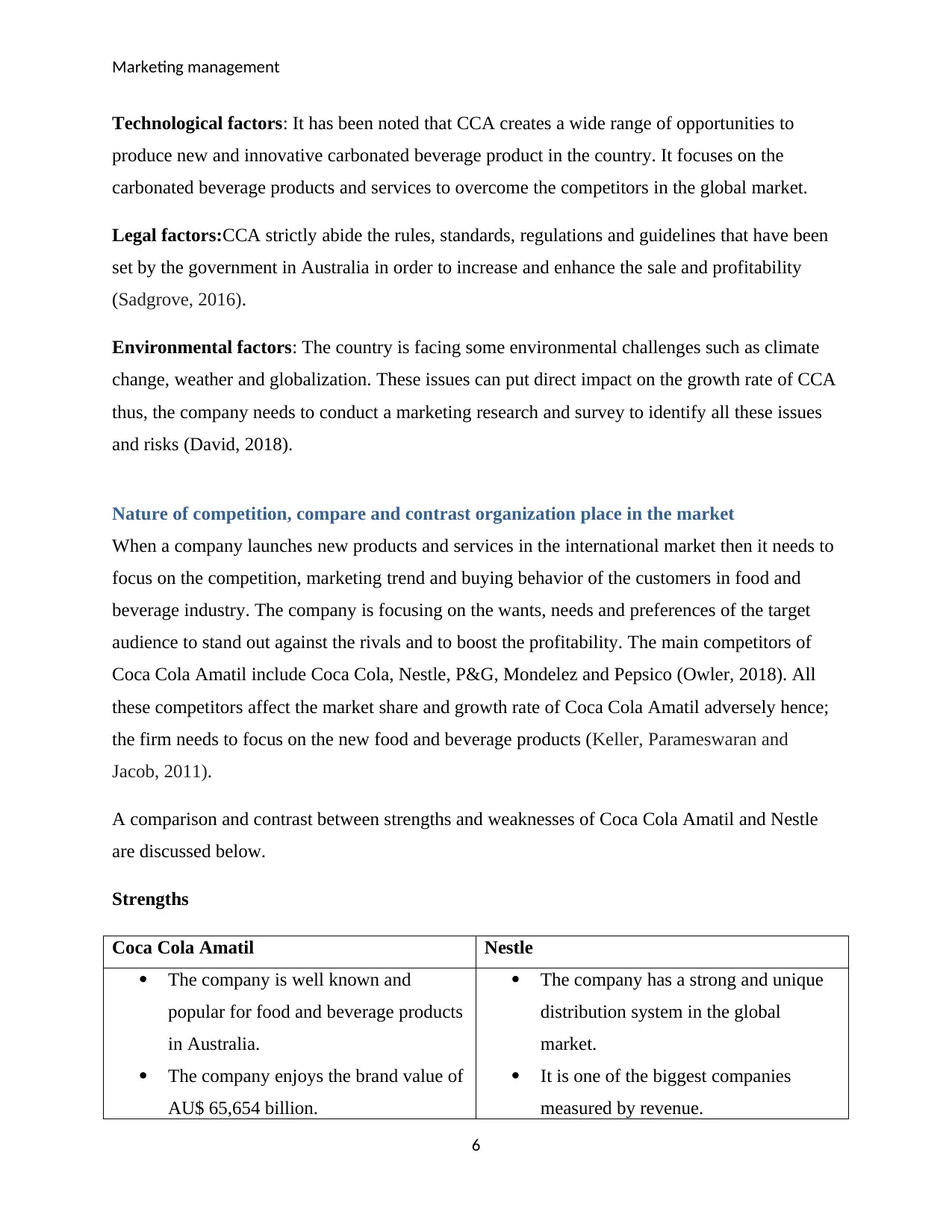
Marketing management
Technological factors: It has been noted that CCA creates a wide range of opportunities to
produce new and innovative carbonated beverage product in the country. It focuses on the
carbonated beverage products and services to overcome the competitors in the global market.
Legal factors:CCA strictly abide the rules, standards, regulations and guidelines that have been
set by the government in Australia in order to increase and enhance the sale and profitability
(Sadgrove, 2016).
Environmental factors: The country is facing some environmental challenges such as climate
change, weather and globalization. These issues can put direct impact on the growth rate of CCA
thus, the company needs to conduct a marketing research and survey to identify all these issues
and risks (David, 2018).
Nature of competition, compare and contrast organization place in the market
When a company launches new products and services in the international market then it needs to
focus on the competition, marketing trend and buying behavior of the customers in food and
beverage industry. The company is focusing on the wants, needs and preferences of the target
audience to stand out against the rivals and to boost the profitability. The main competitors of
Coca Cola Amatil include Coca Cola, Nestle, P&G, Mondelez and Pepsico (Owler, 2018). All
these competitors affect the market share and growth rate of Coca Cola Amatil adversely hence;
the firm needs to focus on the new food and beverage products (Keller, Parameswaran and
Jacob, 2011).
A comparison and contrast between strengths and weaknesses of Coca Cola Amatil and Nestle
are discussed below.
Strengths
Coca Cola Amatil Nestle
The company is well known and
popular for food and beverage products
in Australia.
The company enjoys the brand value of
AU$ 65,654 billion.
The company has a strong and unique
distribution system in the global
market.
It is one of the biggest companies
measured by revenue.
6
Technological factors: It has been noted that CCA creates a wide range of opportunities to
produce new and innovative carbonated beverage product in the country. It focuses on the
carbonated beverage products and services to overcome the competitors in the global market.
Legal factors:CCA strictly abide the rules, standards, regulations and guidelines that have been
set by the government in Australia in order to increase and enhance the sale and profitability
(Sadgrove, 2016).
Environmental factors: The country is facing some environmental challenges such as climate
change, weather and globalization. These issues can put direct impact on the growth rate of CCA
thus, the company needs to conduct a marketing research and survey to identify all these issues
and risks (David, 2018).
Nature of competition, compare and contrast organization place in the market
When a company launches new products and services in the international market then it needs to
focus on the competition, marketing trend and buying behavior of the customers in food and
beverage industry. The company is focusing on the wants, needs and preferences of the target
audience to stand out against the rivals and to boost the profitability. The main competitors of
Coca Cola Amatil include Coca Cola, Nestle, P&G, Mondelez and Pepsico (Owler, 2018). All
these competitors affect the market share and growth rate of Coca Cola Amatil adversely hence;
the firm needs to focus on the new food and beverage products (Keller, Parameswaran and
Jacob, 2011).
A comparison and contrast between strengths and weaknesses of Coca Cola Amatil and Nestle
are discussed below.
Strengths
Coca Cola Amatil Nestle
The company is well known and
popular for food and beverage products
in Australia.
The company enjoys the brand value of
AU$ 65,654 billion.
The company has a strong and unique
distribution system in the global
market.
It is one of the biggest companies
measured by revenue.
6
⊘ This is a preview!⊘
Do you want full access?
Subscribe today to unlock all pages.

Trusted by 1+ million students worldwide
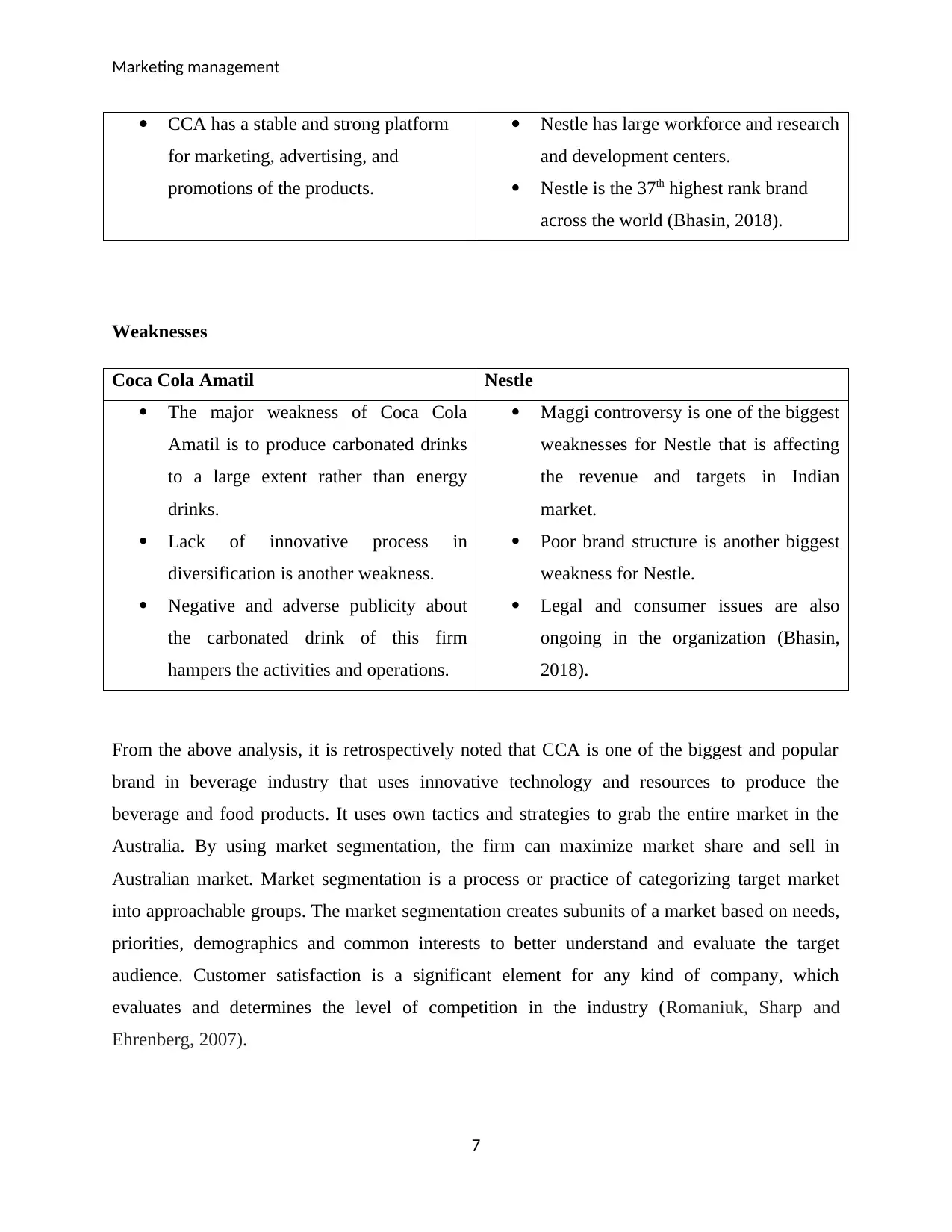
Marketing management
CCA has a stable and strong platform
for marketing, advertising, and
promotions of the products.
Nestle has large workforce and research
and development centers.
Nestle is the 37th highest rank brand
across the world (Bhasin, 2018).
Weaknesses
Coca Cola Amatil Nestle
The major weakness of Coca Cola
Amatil is to produce carbonated drinks
to a large extent rather than energy
drinks.
Lack of innovative process in
diversification is another weakness.
Negative and adverse publicity about
the carbonated drink of this firm
hampers the activities and operations.
Maggi controversy is one of the biggest
weaknesses for Nestle that is affecting
the revenue and targets in Indian
market.
Poor brand structure is another biggest
weakness for Nestle.
Legal and consumer issues are also
ongoing in the organization (Bhasin,
2018).
From the above analysis, it is retrospectively noted that CCA is one of the biggest and popular
brand in beverage industry that uses innovative technology and resources to produce the
beverage and food products. It uses own tactics and strategies to grab the entire market in the
Australia. By using market segmentation, the firm can maximize market share and sell in
Australian market. Market segmentation is a process or practice of categorizing target market
into approachable groups. The market segmentation creates subunits of a market based on needs,
priorities, demographics and common interests to better understand and evaluate the target
audience. Customer satisfaction is a significant element for any kind of company, which
evaluates and determines the level of competition in the industry (Romaniuk, Sharp and
Ehrenberg, 2007).
7
CCA has a stable and strong platform
for marketing, advertising, and
promotions of the products.
Nestle has large workforce and research
and development centers.
Nestle is the 37th highest rank brand
across the world (Bhasin, 2018).
Weaknesses
Coca Cola Amatil Nestle
The major weakness of Coca Cola
Amatil is to produce carbonated drinks
to a large extent rather than energy
drinks.
Lack of innovative process in
diversification is another weakness.
Negative and adverse publicity about
the carbonated drink of this firm
hampers the activities and operations.
Maggi controversy is one of the biggest
weaknesses for Nestle that is affecting
the revenue and targets in Indian
market.
Poor brand structure is another biggest
weakness for Nestle.
Legal and consumer issues are also
ongoing in the organization (Bhasin,
2018).
From the above analysis, it is retrospectively noted that CCA is one of the biggest and popular
brand in beverage industry that uses innovative technology and resources to produce the
beverage and food products. It uses own tactics and strategies to grab the entire market in the
Australia. By using market segmentation, the firm can maximize market share and sell in
Australian market. Market segmentation is a process or practice of categorizing target market
into approachable groups. The market segmentation creates subunits of a market based on needs,
priorities, demographics and common interests to better understand and evaluate the target
audience. Customer satisfaction is a significant element for any kind of company, which
evaluates and determines the level of competition in the industry (Romaniuk, Sharp and
Ehrenberg, 2007).
7
Paraphrase This Document
Need a fresh take? Get an instant paraphrase of this document with our AI Paraphraser

Marketing management
Major market segments (Primary and secondary market)
Market segmentation is needed to survive and explore the business internationally. It is a process
of categorizing the products and services into the multiple units to penetrate the entire market.
By using market segmentation approach, CCA has been able to lure the wide range of customers
globally (Romaniuk, Sharp and Ehrenberg, 2007). Segmentation is done by the company after
considering the various areas such as geographic, behavioral, demographic and psychographic
areas. By understanding and evaluating the market, CCA can leverage this targeting in
marketing, product and sales strategies (Hiebeler, Kelly and Ketteman, 2012). Customer
satisfaction is a significant element for any kind of company, which evaluates and determines the
level of competition in the industry.
Primary market: Primary target market plays a significant role in attaining competitive
advantages in the global market. Primary target market is further helps in increasing and
boosting the sale and outputs of CCA. A marketing research and survey are done by CCA to
identify and measure the potential and effective target audience to a large extent. The primary
target market of Coca Cola Amatil is kids and youngsters which belong to middle, lower and
upper classes (Shenkar, Luo and Chi, 2014). The primary target market purchases food and
beverage products to a large extent for aiming to generate more and more profit and returns.
Apart from this, the company targets all age groups from kids and to adults who like to purchase
beverage and food products. The success and growth of the company is dependent on the
primary target market. CCA maintains good and reciprocal relationship with primary target
audience to struggle with rivals at international level. The company supports and respects the
primary role that parents play in decisions influencing the lives of young children including
preferences, choices and wants about lifestyle and diet. Beverage and food choice like food
selection is a role for all parents and CCA promotes and assists them by providing ample of
information related to product suitability. The sampling events and programs are targeted to
people over the age of 12 (Jay Polonsky, 2008).
Secondary market: The secondary market is an organization and it is very significant and
unique for CCA to uplift revenue. The key target audience in this group may have fewer
demands and requirements for the drinks and beverage products of the firm. This market is also
needed for every organization to make a good brand reputation in the minds of the key target
8
Major market segments (Primary and secondary market)
Market segmentation is needed to survive and explore the business internationally. It is a process
of categorizing the products and services into the multiple units to penetrate the entire market.
By using market segmentation approach, CCA has been able to lure the wide range of customers
globally (Romaniuk, Sharp and Ehrenberg, 2007). Segmentation is done by the company after
considering the various areas such as geographic, behavioral, demographic and psychographic
areas. By understanding and evaluating the market, CCA can leverage this targeting in
marketing, product and sales strategies (Hiebeler, Kelly and Ketteman, 2012). Customer
satisfaction is a significant element for any kind of company, which evaluates and determines the
level of competition in the industry.
Primary market: Primary target market plays a significant role in attaining competitive
advantages in the global market. Primary target market is further helps in increasing and
boosting the sale and outputs of CCA. A marketing research and survey are done by CCA to
identify and measure the potential and effective target audience to a large extent. The primary
target market of Coca Cola Amatil is kids and youngsters which belong to middle, lower and
upper classes (Shenkar, Luo and Chi, 2014). The primary target market purchases food and
beverage products to a large extent for aiming to generate more and more profit and returns.
Apart from this, the company targets all age groups from kids and to adults who like to purchase
beverage and food products. The success and growth of the company is dependent on the
primary target market. CCA maintains good and reciprocal relationship with primary target
audience to struggle with rivals at international level. The company supports and respects the
primary role that parents play in decisions influencing the lives of young children including
preferences, choices and wants about lifestyle and diet. Beverage and food choice like food
selection is a role for all parents and CCA promotes and assists them by providing ample of
information related to product suitability. The sampling events and programs are targeted to
people over the age of 12 (Jay Polonsky, 2008).
Secondary market: The secondary market is an organization and it is very significant and
unique for CCA to uplift revenue. The key target audience in this group may have fewer
demands and requirements for the drinks and beverage products of the firm. This market is also
needed for every organization to make a good brand reputation in the minds of the key target
8

Marketing management
audience. The secondary market of CCA includes women, households and adults. This target
market also includes student and teenagers who like to drink energy beverages. These people buy
drink and beverage products for taste. It is studied from the various analysis that the demands
and needs of secondary market is less in comparison to primary target market (Noel, 2009).
Level of involvement of primary segment
It is noted that customer analysis helps the firm to generate an effective and efficient marketing
plan according to needs and wants of its clients. It is vital for measuring and recognizing the
targeted market of CCA in order to identify the needs and requirements of the customers.
Customer analysis is a valuable framework to measure and know their desires and choices
regarding the food and beverage products. Market segmentation, targeting and positioning play a
major role in identifying and measuring the level of involvement of primary market in decision
making process (Lambert, 2009). When CCA launches new product and service in the market
then it focuses on the demands of the primary market so that correction can be done easily.
Market research and survey are conducted by CCA before launching new products in the market.
After focusing its primary market, CCA takes good and right decisions for selling the food and
drinks products globally. Marketing research and survey can be done by dividing the market into
different segmentation like geographic, demographic, psychographic and behavioral. It also
focuses on the lifestyle, age, market trends and choices of primary target market in order to beat
the competitors. After deciding the market segmentation, targeting and positioning strategies
shall be used by the firm for analyzing dynamic and effective target market and catering the
products and services (Wheelen and Hunger, 2011). CCA has engaged with multiple potential
managers to make a through market research about the carbonated and energy beverages and
uses suitable and effective strategy to maximize its standing position. To retain the customers,
CCA focuses on the prices of soft drinks and beverage in the global market. By using innovative
and dynamic pricing strategy, the company can lure maximum customers for selling the
products. After completing targeting strategy, positioning needs to be done, CCA would position
the beverage products after considering the prices of competitors. Identification of primary target
market is needed for decision making process, as CCA also focuses on the promotional methods,
prices, quality and strategies of the competitors to increase and enhance the demand of beverage
9
audience. The secondary market of CCA includes women, households and adults. This target
market also includes student and teenagers who like to drink energy beverages. These people buy
drink and beverage products for taste. It is studied from the various analysis that the demands
and needs of secondary market is less in comparison to primary target market (Noel, 2009).
Level of involvement of primary segment
It is noted that customer analysis helps the firm to generate an effective and efficient marketing
plan according to needs and wants of its clients. It is vital for measuring and recognizing the
targeted market of CCA in order to identify the needs and requirements of the customers.
Customer analysis is a valuable framework to measure and know their desires and choices
regarding the food and beverage products. Market segmentation, targeting and positioning play a
major role in identifying and measuring the level of involvement of primary market in decision
making process (Lambert, 2009). When CCA launches new product and service in the market
then it focuses on the demands of the primary market so that correction can be done easily.
Market research and survey are conducted by CCA before launching new products in the market.
After focusing its primary market, CCA takes good and right decisions for selling the food and
drinks products globally. Marketing research and survey can be done by dividing the market into
different segmentation like geographic, demographic, psychographic and behavioral. It also
focuses on the lifestyle, age, market trends and choices of primary target market in order to beat
the competitors. After deciding the market segmentation, targeting and positioning strategies
shall be used by the firm for analyzing dynamic and effective target market and catering the
products and services (Wheelen and Hunger, 2011). CCA has engaged with multiple potential
managers to make a through market research about the carbonated and energy beverages and
uses suitable and effective strategy to maximize its standing position. To retain the customers,
CCA focuses on the prices of soft drinks and beverage in the global market. By using innovative
and dynamic pricing strategy, the company can lure maximum customers for selling the
products. After completing targeting strategy, positioning needs to be done, CCA would position
the beverage products after considering the prices of competitors. Identification of primary target
market is needed for decision making process, as CCA also focuses on the promotional methods,
prices, quality and strategies of the competitors to increase and enhance the demand of beverage
9
⊘ This is a preview!⊘
Do you want full access?
Subscribe today to unlock all pages.

Trusted by 1+ million students worldwide
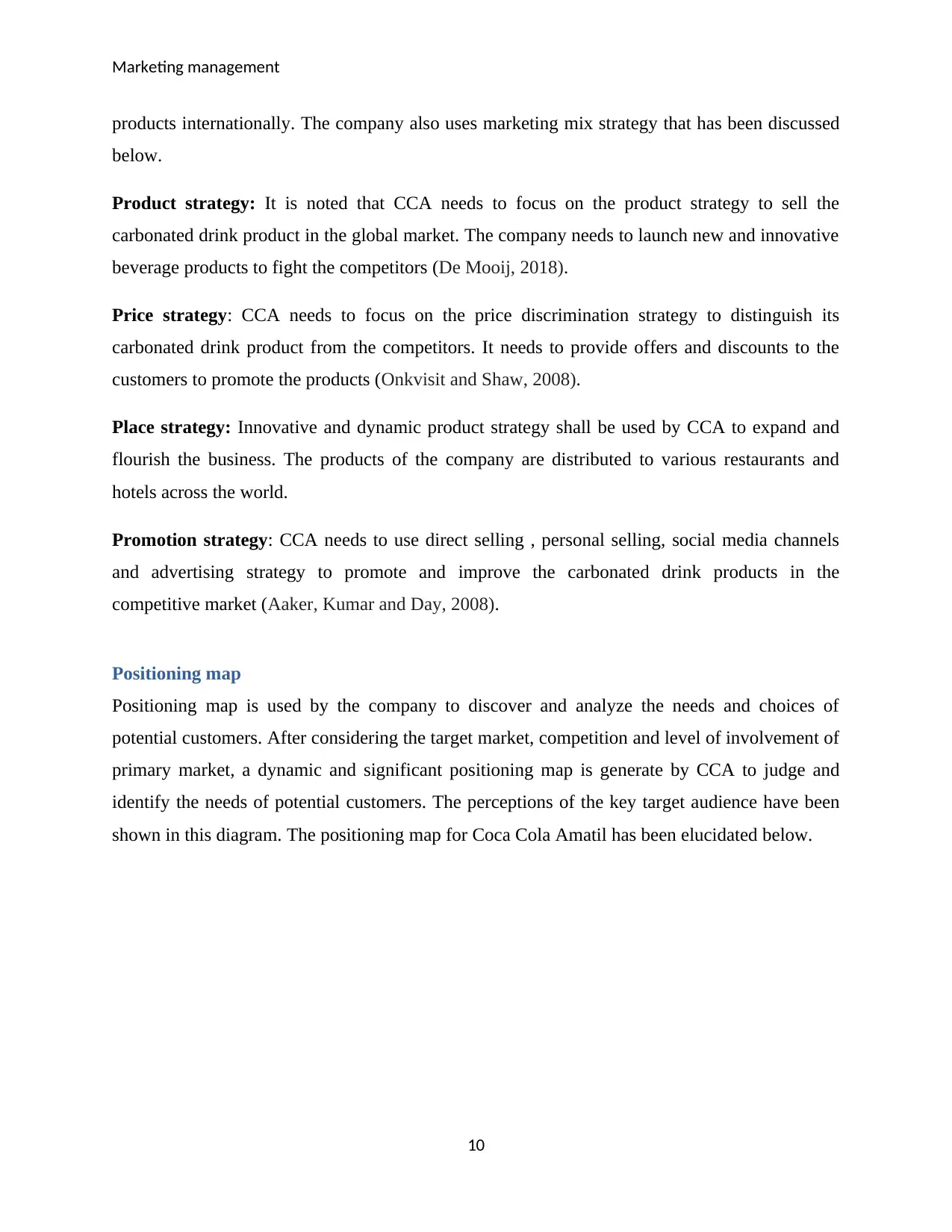
Marketing management
products internationally. The company also uses marketing mix strategy that has been discussed
below.
Product strategy: It is noted that CCA needs to focus on the product strategy to sell the
carbonated drink product in the global market. The company needs to launch new and innovative
beverage products to fight the competitors (De Mooij, 2018).
Price strategy: CCA needs to focus on the price discrimination strategy to distinguish its
carbonated drink product from the competitors. It needs to provide offers and discounts to the
customers to promote the products (Onkvisit and Shaw, 2008).
Place strategy: Innovative and dynamic product strategy shall be used by CCA to expand and
flourish the business. The products of the company are distributed to various restaurants and
hotels across the world.
Promotion strategy: CCA needs to use direct selling , personal selling, social media channels
and advertising strategy to promote and improve the carbonated drink products in the
competitive market (Aaker, Kumar and Day, 2008).
Positioning map
Positioning map is used by the company to discover and analyze the needs and choices of
potential customers. After considering the target market, competition and level of involvement of
primary market, a dynamic and significant positioning map is generate by CCA to judge and
identify the needs of potential customers. The perceptions of the key target audience have been
shown in this diagram. The positioning map for Coca Cola Amatil has been elucidated below.
10
products internationally. The company also uses marketing mix strategy that has been discussed
below.
Product strategy: It is noted that CCA needs to focus on the product strategy to sell the
carbonated drink product in the global market. The company needs to launch new and innovative
beverage products to fight the competitors (De Mooij, 2018).
Price strategy: CCA needs to focus on the price discrimination strategy to distinguish its
carbonated drink product from the competitors. It needs to provide offers and discounts to the
customers to promote the products (Onkvisit and Shaw, 2008).
Place strategy: Innovative and dynamic product strategy shall be used by CCA to expand and
flourish the business. The products of the company are distributed to various restaurants and
hotels across the world.
Promotion strategy: CCA needs to use direct selling , personal selling, social media channels
and advertising strategy to promote and improve the carbonated drink products in the
competitive market (Aaker, Kumar and Day, 2008).
Positioning map
Positioning map is used by the company to discover and analyze the needs and choices of
potential customers. After considering the target market, competition and level of involvement of
primary market, a dynamic and significant positioning map is generate by CCA to judge and
identify the needs of potential customers. The perceptions of the key target audience have been
shown in this diagram. The positioning map for Coca Cola Amatil has been elucidated below.
10
Paraphrase This Document
Need a fresh take? Get an instant paraphrase of this document with our AI Paraphraser

Marketing management
High price
Nestle Coca Cola
CCA Mondelez
Low quality High quality
Low price
The positioning map of CCA reveals that the firm is taking unique and effective decisions after
considering the choices, needs and wants of the primary target market. It is targeting all types of
customers who buy beverage products for tastes. The company uses differentiation and
diversification strategies to distinguish its products from the rivals.
Conclusion
It is concluded from the above limelight event that customer analysis and marketing analysis are
essential to satisfy the needs and demands of the customers. CCA uses innovative strategies and
policies to overcome the competitors and to attract maximum customers in the competitive
market. It is worth analyzed from the above discussion that CCA is increasing growth rate,
profitability and revenue by offering innovative carbonated drinks and beverage products. Along
with this, the paper also reveals that primary and secondary market play a major role in attracting
and retaining wide range of key target audience at international level. The company uses
segmentation, targeting and positioning strategies to identify and evaluate the potential and
efficient target audience. The customers involve in decision making process of CCA. CCA
11
High price
Nestle Coca Cola
CCA Mondelez
Low quality High quality
Low price
The positioning map of CCA reveals that the firm is taking unique and effective decisions after
considering the choices, needs and wants of the primary target market. It is targeting all types of
customers who buy beverage products for tastes. The company uses differentiation and
diversification strategies to distinguish its products from the rivals.
Conclusion
It is concluded from the above limelight event that customer analysis and marketing analysis are
essential to satisfy the needs and demands of the customers. CCA uses innovative strategies and
policies to overcome the competitors and to attract maximum customers in the competitive
market. It is worth analyzed from the above discussion that CCA is increasing growth rate,
profitability and revenue by offering innovative carbonated drinks and beverage products. Along
with this, the paper also reveals that primary and secondary market play a major role in attracting
and retaining wide range of key target audience at international level. The company uses
segmentation, targeting and positioning strategies to identify and evaluate the potential and
efficient target audience. The customers involve in decision making process of CCA. CCA
11

Marketing management
creates a perceptual map after focusing on the competition, primary market and level of
involvement of primary target market.
12
creates a perceptual map after focusing on the competition, primary market and level of
involvement of primary target market.
12
⊘ This is a preview!⊘
Do you want full access?
Subscribe today to unlock all pages.

Trusted by 1+ million students worldwide
1 out of 14
Related Documents
Your All-in-One AI-Powered Toolkit for Academic Success.
+13062052269
info@desklib.com
Available 24*7 on WhatsApp / Email
![[object Object]](/_next/static/media/star-bottom.7253800d.svg)
Unlock your academic potential
Copyright © 2020–2025 A2Z Services. All Rights Reserved. Developed and managed by ZUCOL.





